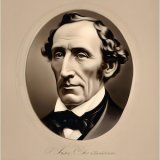The Girl Who Trod on the Loaf Page #2
"The Girl Who Trod on the Loaf" is a classic fairy tale by Hans Christian Andersen. It tells the story of a young, proud and vain girl named Inger who, in order to save her new shoes from mud, throws her loaf of bread on the mucky ground to step over it. As a punishment for wasting food and showing arrogance, she falls into the underworld where she suffers harsh consequences. The story explores themes of vanity, pride, and redemption, and is a moral tale about the dangers of these follies.
Genre: Children
Genre: Children
- 19 Views
hast caused thy mother" she would say, "Oh that I had never been born! My mother's tears are useless now." And then the words of the kind people who had adopted her came to her ears, when they said, "Inge was a sinful girl, who did not value the gifts of God, but trampled them under her feet." "Ah," thought Inge, "they should have punished me, and driven all my naughty tempers out of me." A song was made about "The girl who trod on a loaf to keep her shoes from being soiled," and this song was sung everywhere. The story of her sin was also told to the little children, and they called her "wicked Inge," and said she was so naughty that she ought to be punished. Inge heard all this, and her heart became hardened and full of bitterness. But one day, while hunger and grief were gnawing in her hollow frame, she heard a little, innocent child, while listening to the tale of the vain, haughty Inge, burst into tears and exclaim, "But will she never come up again?" And she heard the reply, "No, she will never come up again." "But if she were to say she was sorry, and ask pardon, and promise never to do so again?" asked the little one. "Yes, then she might come; but she will not beg pardon," was the answer. "Oh, I wish she would!" said the child, who was quite unhappy about it. "I should be so glad. I would give up my doll and all my playthings, if she could only come here again. Poor Inge! it is so dreadful for her." These pitying words penetrated to Inge's inmost heart, and seemed to do her good. It was the first time any one had said, "Poor Inge!" without saying something about her faults. A little innocent child was weeping, and praying for mercy for her. It made her feel quite strange, and she would gladly have wept herself, and it added to her torment to find she could not do so. And while she thus suffered in a place where nothing changed, years passed away on earth, and she heard her name less frequently mentioned. But one day a sigh reached her ear, and the words, "Inge! Inge! what a grief thou hast been to me! I said it would be so." It was the last sigh of her dying mother. After this, Inge heard her kind mistress say, "Ah, poor Inge! shall I ever see thee again? Perhaps I may, for we know not what may happen in the future." But Inge knew right well that her mistress would never come to that dreadful place. Time-passed--a long bitter time--then Inge heard her name pronounced once more, and saw what seemed two bright stars shining above her. They were two gentle eyes closing on earth. Many years had passed since the little girl had lamented and wept about "poor Inge." That child was now an old woman, whom God was taking to Himself. In the last hour of existence the events of a whole life often appear before us; and this hour the old woman remembered how, when a child, she had shed tears over the story of Inge, and she prayed for her now. As the eyes of the old woman closed to earth, the eyes of the soul opened upon the hidden things of eternity, and
Translation
Translate and read this book in other languages:
Select another language:
- - Select -
- 简体中文 (Chinese - Simplified)
- 繁體中文 (Chinese - Traditional)
- Español (Spanish)
- Esperanto (Esperanto)
- 日本語 (Japanese)
- Português (Portuguese)
- Deutsch (German)
- العربية (Arabic)
- Français (French)
- Русский (Russian)
- ಕನ್ನಡ (Kannada)
- 한국어 (Korean)
- עברית (Hebrew)
- Gaeilge (Irish)
- Українська (Ukrainian)
- اردو (Urdu)
- Magyar (Hungarian)
- मानक हिन्दी (Hindi)
- Indonesia (Indonesian)
- Italiano (Italian)
- தமிழ் (Tamil)
- Türkçe (Turkish)
- తెలుగు (Telugu)
- ภาษาไทย (Thai)
- Tiếng Việt (Vietnamese)
- Čeština (Czech)
- Polski (Polish)
- Bahasa Indonesia (Indonesian)
- Românește (Romanian)
- Nederlands (Dutch)
- Ελληνικά (Greek)
- Latinum (Latin)
- Svenska (Swedish)
- Dansk (Danish)
- Suomi (Finnish)
- فارسی (Persian)
- ייִדיש (Yiddish)
- հայերեն (Armenian)
- Norsk (Norwegian)
- English (English)
Citation
Use the citation below to add this book to your bibliography:
Style:MLAChicagoAPA
"The Girl Who Trod on the Loaf Books." Literature.com. STANDS4 LLC, 2024. Web. 17 May 2024. <https://www.literature.com/book/the_girl_who_trod_on_the_loaf_2169>.




Discuss this The Girl Who Trod on the Loaf book with the community:
Report Comment
We're doing our best to make sure our content is useful, accurate and safe.
If by any chance you spot an inappropriate comment while navigating through our website please use this form to let us know, and we'll take care of it shortly.
Attachment
You need to be logged in to favorite.
Log In